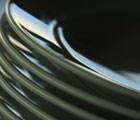 |
 |
 |
 |
 |
|
Modern Uses For Ceramics We commonly think of ceramics as art objects and decorations. But ceramics really are diverse pieces of multi-purpose material that are made from burning formed pieces of pottery. This shaped clay started out many years ago being hand-formed and was eventually made with a wheel to iron out any fingerprints or major imperfections.
|
|
ArticlesTips on Getting Strikes in BowlingIt is important to remember that strikes may be exciting, might give you good points as well but it is only part of the bowling game. And you need to look for the bigger and better bowling. And in this game speed is also not the only thing to score points, even though they may give you sometime. Everybody likes to make strikes. I'm no exception. Even after many years spent in wheeling that ball down the lanes, I still get a real thrill out of seeing a perfect strike sweep the pins clean. Strikes serve a dual purpose. First, they bring a bonus because they count ten points each, plus all you can score on your two succeeding throws. Then, too, they automatically remove any chance you might have had of either missing a spare or getting a split, or railroad. Novices, as well as a good many veteran bowlers, are tremendously impressed by strikes, so much so that they neglect the rest of their game in a dogged effort to chalk up that magic "x" in the corner of the frame set aside for "Marks." Unfortunately, they concentrate so much on this phase of the game that their improvement is slowed down, for anyone who develops an accurate spare delivery automatically improves in the strike department. It's a good deal like a rookie pitcher in the big leagues. When he first hits the majors, he thinks the idea is to impress everyone by striking out every batter. He looks good, too, for a short time. Then the wily veterans begin to wait him out and to plaster his fast ball to distant places. A few such hammerings and he begins to perceive that strike-outs are only a means to an end the real idea is to keep the batters from hitting the ball cleanly. When he smartens up a little, he starts "mixing up" his deliveries, tossing a curve, slow ball, a drop, or other deliveries which he may have evolved, and he saves his "fast one" for a real pinch. Then he is on his way to being a winning pitcher. This is also true of the bowling beginner. When he learns that strikes are only part of the game and not the entire game, he is on his way to bigger and better bowling. Many beginners think that blinding speed is the way to score strikes. So they get on the approach, back up as far as they can, rush madly to the foul line and let fly with all their strength. Occasionally they do score a strike the law of averages takes care of that. But more often they clip off three or four pins and miss the headpin completely. Their spare shots are almost automatic misses and they are genuinely surprised when they hit the remaining pins. All they are making of the game of bowling is a "strike or no-count" proposition. Such bowlers seldom succeed in becoming good at the game. Now, let's take up the matter of how to make strikes. First, because of the pattern in which the ten pins are arranged, all of them can be toppled more often by directing the ball into the 1-3 pocket (the space between the 1-pin and the 3-pin) than into any other place. One might score strikes in almost any other fashion, too, but the 1-3 pocket furnishes by far the greatest chance for success. The ball, on such a hit, -strikes the 1-pin, then the 3-pin, next the 5-pin, and finally the 9-pin, the other pins being accounted for by the action of these pins. Having determined that the ideal spot at which your ball should contact the pins is the 1\3 pocket, let us take up one at a time the type of ball to be delivered. There are four main divisions the straight ball, hook, curve and backup. THE STRAIGHT BALL Unless you throw a natural hook from the first time you pick up a bowling ball, I suggest the use of a straight ball until control has been mastered. All too many beginners see the experts using an effective hook and try to copy it without first laying a solid ground- work of footwork and timing. The straight ball is delivered with no turn of the wrist or fingers, the ball being released with the thumb on top and the fingers underneath. As a general rule, it is the easiest to throw, but the straight ball is not a great "strike-getter" like the hook and the curve, because it does not produce a real "mixing" action on the pins, and it is easily deflected. When you begin with the straight ball, however, you have a more natural delivery and consequently make fewer mistakes. The bowling beginner who immediately starts out throwing a hook must watch not only his stance, footwork and timing, but in addition must co-ordinate perfectly his release of the ball in order to make certain that all other departments of his game are working correctly. Otherwise he may be at a loss to discover just where he is making his mistakes. As a beginner you can try to throw a straight ball. It is the easiest to throw, but the straight ball is not a great "strike-getter" like the hook and the curve. After this straight ball you have a more natural delivery and consequently make fewer mistakes. Mitch Johnson is a regular writer for http://www.1-scuba-diving-gear.com/ , http://www.www.bikingguide.info/ , http://www.ezbikinghub.info/ Pottery and Ceramics Phoenix Gay Chat Lines Numbers - Review the easiest gay chat lines numbers around Phoenix AZ Lancaster Gay Chat Rooms Free - Make sure you check out the utmost gay chat rooms free inside Lancaster CA Blackjack Doubling Down - Doubling Down Poker How to Choose Your New Home Theater System - It is always a big undertaking when you decide to choose any new equipment especially a home theater system. Blackjack and Poker Tips - The objective of Blackjack is to get the total value of your cards to 21 or as near to it as possible. more... |
|
ęCopyright 2026 Tianxin-ceramic. All rights reserved. Unauthorized duplication in part or whole strictly prohibited by international copyright law. |
